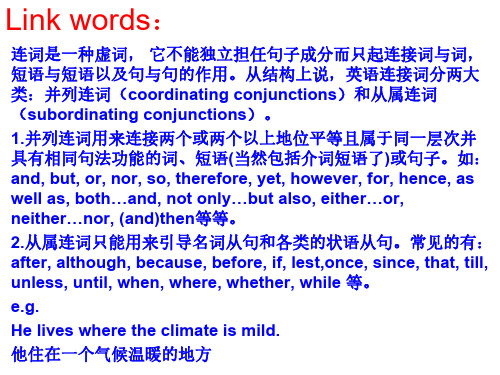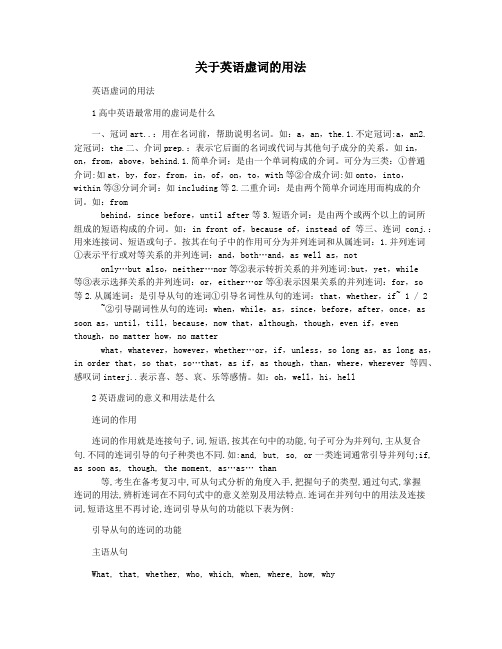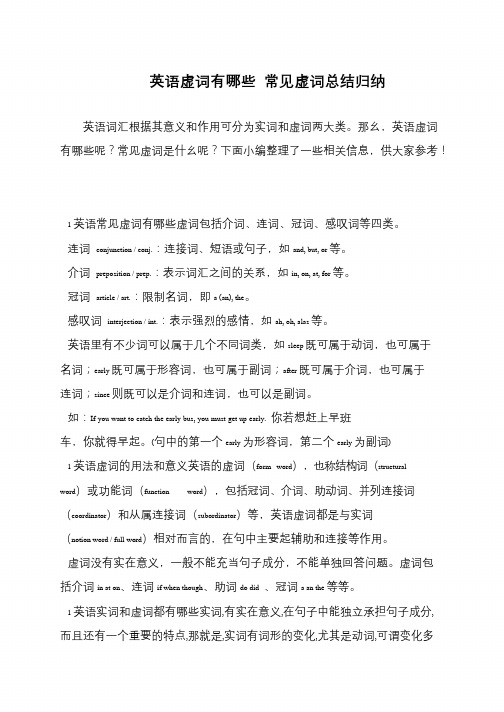高一英语虚词复习
- 格式:ppt
- 大小:127.00 KB
- 文档页数:7


18个虚词在英语语法中,有一类词语被称为“虚词”。
虚词是指在句子中没有实际意义的词语,它们通常用来连接其他词语、短语或句子,并且起到连接或修饰的作用。
在本文中,我们将介绍18个常见的虚词,并且给出它们在句子中的用法和示例。
1. 介词(Prepositions)介词是一种常见的虚词,它们用来表示位置、方向、时间、原因等等。
以下是一些常见的介词及其用法:•in:表示在某个地方或范围内,在句子中可以用来表示时间、地点或状态。
例如:–She lives in New York.(她住在纽约。
)–My birthday is in July.(我的生日是在七月。
)–He is in a bad mood.(他心情不好。
)•on:表示在某个具体的表面上,在句子中可以用来表示时间、地点或状态。
例如:–The book is on the table.(书在桌子上。
)–I have a meeting on Monday.(我星期一有一个会议。
)–She is on vacation.(她在度假。
)•at:表示在某个具体的地点或时间点上,在句子中通常用来表示地点、时间或具体事件。
例如:–I will meet you at the cafe.(我会在咖啡馆见你。
)–The party starts at7 o’clock.(派对将在7点开始。
)–They are good at playing soccer.(他们擅长踢足球。
)2. 代词(Pronouns)代词可以替代名词或名词短语,在句子中用来指代前文或特定对象。
以下是一些常见的代词及其用法:•he:代替第三人称男性单数,在句子中用来指代男性。
例如:–He is a doctor.(他是医生。
)–I saw him in the park.(我在公园里看到了他。
)•she:代替第三人称女性单数,在句子中用来指代女性。
例如:–She is a teacher.(她是教师。

虚词知识点总结虚词,是指在句子中用来构成语法结构、句子成份、句子成分及句法功能,但是没有实际词义的词。
虚词在句子中不具备独立的概念意义,在句子中起到连接词、助词、介词、助动词等作用。
虚词的一部分出现频繁,有许多虚词在句子中经常出现,它们是构成语法结构不可或缺的组成部分。
一、虚词的分类1. 连词连词是由且、而、若等词组成的词类,其作用是连接词与词、词组与词组、分句与分句等。
例如:“她和你一起去”中的“和”就是连词。
2. 助词助词是表示人称、数、时态、语气等语法关系的一种虚词。
例如:“我在等你”中的“在”就是助词。
3. 介词介词是用于表示事物和事物,事物和人之间的方位、时间、原因、目的、原料、手段等关系词。
例如:“在桌子上”中的“在”就是介词。
4. 动词助动词是一种具有特定语法功能的词,用来辅助说明行为动词的时态、语态、语气和否定等。
例如:“他会来”中的“会”就是助动词。
5. 叹词叹词是表示感叹、赞叹、疑问等情感或语气的词。
例如:“哎呀!”中的“哎”就是叹词。
6. 语气词语气词是表示说话者的语气、情感等意义的词。
例如:“吧、呢、啊”等就是语气词。
7. 结构助词结构助词是构成句子成分的虚词,包括“的、得、地”等。
例如:“漂亮的花朵”中的“的”就是结构助词。
8. 感叹词感叹词是表示感情的词语,如“哇、好啊”。
例如:“哇,好漂亮啊!”中的“哇”就是感叹词。
二、虚词的特点1. 没有实际词义虚词在句子中不具备独立的词义,它们没有具体的实际意义。
2. 起到连接作用虚词在句子中起到连接词、助词、介词、助动词等作用,用来构成语法结构、句子成份及句法功能。
3. 不可或缺虚词在句子中不可或缺,是构成语法结构不可或缺的组成部分。
4. 语法功能明显虚词在句子中具有明显的语法功能,能够表达人称、数、时态、语气等语法关系。
三、虚词的使用虚词在句子中起到连接词、助词、介词、助动词等作用,用来构成语法结构、句子成份及句法功能。
在句子中,虚词需要根据句子的语境和语法规则来正确使用,以确保句子表达的准确和通顺。

关于英语虚词的用法英语虚词的用法1高中英语最常用的虚词是什么一、冠词art..:用在名词前,帮助说明名词。
如:a,an,the.1.不定冠词:a,an2.定冠词:the二、介词prep.:表示它后面的名词或代词与其他句子成分的关系。
如in,on,from,above,behind.1.简单介词:是由一个单词构成的介词。
可分为三类:①普通介词:如at,by,for,from,in,of,on,to,with等②合成介词:如onto,into,within等③分词介词:如including等2.二重介词:是由两个简单介词连用而构成的介词。
如:frombehind,since before,until after等3.短语介词:是由两个或两个以上的词所组成的短语构成的介词。
如:in front of,because of,instead of等三、连词conj.:用来连接词、短语或句子。
按其在句子中的作用可分为并列连词和从属连词:1.并列连词①表示平行或对等关系的并列连词:and,both…and,as well as,notonly…but also,neither…nor等②表示转折关系的并列连词:but,yet,while等③表示选择关系的并列连词:or,either…or等④表示因果关系的并列连词:for,so等2.从属连词:是引导从句的连词①引导名词性从句的连词:that,whether,if~ 1 / 2 ~②引导副词性从句的连词:when,while,as,since,before,after,once,as soon as,until,till,because,now that,although,though,even if,even though,no matter how,no matterwhat,whatever,however,whether…or,if,unless,so long as,as long as,in order that,so that,so…that,as if,as though,than,where,wherever等四、感叹词interj..表示喜、怒、哀、乐等感情。

英语虚词有哪些常见虚词总结归纳英语词汇根据其意义和作用可分为实词和虚词两大类。
那幺,英语虚词有哪些呢?常见虚词是什幺呢?下面小编整理了一些相关信息,供大家参考!1 英语常见虚词有哪些虚词包括介词、连词、冠词、感叹词等四类。
连词conjunction / conj.:连接词、短语或句子,如and, but, or 等。
介词preposition / prep.:表示词汇之间的关系,如in, on, at, for 等。
冠词article / art.:限制名词,即a (an), the。
感叹词interjection / int.:表示强烈的感情,如ah, oh, alas 等。
英语里有不少词可以属于几个不同词类,如sleep 既可属于动词,也可属于名词;early 既可属于形容词,也可属于副词;after 既可属于介词,也可属于连词;since 则既可以是介词和连词,也可以是副词。
如:If you want to catch the early bus, you must get up early. 你若想赶上早班车,你就得早起。
(句中的第一个early 为形容词,第二个early 为副词)1 英语虚词的用法和意义英语的虚词(form word),也称结构词(structural word)或功能词(function word),包括冠词、介词、助动词、并列连接词(coordinator)和从属连接词(subordinator)等,英语虚词都是与实词(notion word / full word)相对而言的,在句中主要起辅助和连接等作用。
虚词没有实在意义,一般不能充当句子成分,不能单独回答问题。
虚词包括介词in at on、连词if when though、助词do did 、冠词a an the 等等。
1 英语实词和虚词都有哪些实词,有实在意义,在句子中能独立承担句子成分,而且还有一个重要的特点,那就是,实词有词形的变化,尤其是动词,可谓变化多。

高中18个虚词整理
1.的:表示所属关系,如我的、他的等,也可作连词、指示代词、助词等。
2.地:副词后缀,表示方式、状态、程度等,如认真地、顺利地等。
3.得:副词后缀,表示程度、结果等,如高兴得不得了、跑得飞
快等。
4.和:连词,表示并列关系,如父母和孩子、唱歌和跳舞等。
5.与:介词,表示具有共同点或关系,如与你相识、与时俱进等。
6.在:介词,表示存在、处于某种状态或位置,如在家、在办公
室等。
7.为:介词,表示目的、原因、代表等,如为了、为了使他高兴等。
8.向:介词,表示方向、目的、倾向等,如向前、向往光明等。
9.用:介词,表示使用工具、方式等,如用笔写字、用力抬起等。
10.于:介词,表示时间、地点、关系等,如于2010年、于我而
言等。
11.从:介词,表示来源、由某个时间或事物开始等,如从未见过、从头到尾等。
12.以:介词,表示方法、手段、条件等,如以书为友、以此为例等。
13.因:介词,表示原因、由于等,如因为天气原因、因此不得不
离开等。
14.但:连词,表示转折或逻辑关系,如他很聪明,但是很懒惰。
15.虽然:连词,表示让步或条件,如虽然下雨,但是他还是去了。
16.如果:连词,表示假设或条件,如如果我早点起床,可能不会
迟到。
17.把:介词,表示动作的承受者,如把书放在桌子上。
18.被:介词,表示动作的执行者,如被雨淋湿了。
英语虚词大全
1、the:英文单词,定冠词、副词,作定冠词时意为“这;那”,作副词时意为“更加(用于比较级,最高级前)”。
2、above:above是一个英语单词,介词、副词、形容词、名词。
作介词时意为“超过,多于,胜过;高于;在……上面;在……之上;(因善良或诚实正直而)不至于,不屑于(做某事);偏向于,优先于;”。
3、before:英语单词,介词,意为“在……之前,先于;在……面前;”。
4、should:英文单词,情态动词,作情态动词时意为“应该;就;可能;将要;本当;竟然”。
5、will:英文单词,助动词、动词、名词,作助动词时意为“将;总是;愿意;(表示能力、容量等)能;惯于;可能;必须”,作动词时意为“愿意;(诗、文)想要;决心要;用意志力使;遗赠”,作名词时意为“意愿,意志,决心;心愿;遗嘱;意旨”。
五大虚词之1.结构助词,的。
举例:春冬之时。
/以天下之所顺攻亲戚之所畔2.第三人称代词,它,他。
例句:委而去之。
3.指示代词,这,这种。
例句:魁父之丘。
4.取消句独。
例句:虽我之死,有子存焉。
/予独爱莲之出淤泥而不染。
5.动词,去,到。
例句:多助之至。
/往送之门。
/已而之细柳军。
6.倒装标志。
例句:何陋之有?/菊之爱,陶后鲜有闻。
7.补足音节。
例句:称善者久之。
以1.动词,认为,以为。
例句:不以疾也。
/自以为大有所益。
2.连词,表目的,来,用来。
例句:以备胡。
/河曲智叟亡以应。
/意将隧入以攻其后也。
静以修身,俭以养德。
非淡泊无以明志,非宁静无以致远。
3.介词,表方式或手段。
用,按照。
例句:所以动心忍性。
/请以军礼见。
/蒙辞以军中多务4.介词,把。
(以……为……,把……当作……)例句:以顺为正者。
/乃以宗正刘礼为将军。
5.介词,表原因。
因,因为。
例句:暂缺6.介词,凭,凭借。
例句:域民不以封疆之界。
/以君之力。
(介宾)/公亦以此自矜。
7.介词,凭借……身份。
例句:暂缺8.介词,在……时候例句:暂缺而1.连词,表并列。
和,又,并且。
例句:然后知生于忧患而死于安乐也。
2.连词,表承接,然后。
例句:一怒而诸侯惧。
/困于心衡于虑,而后作。
3.连词,表转折。
可是。
例句:然而不胜者。
/而山不加增。
4.连词,用于状中之间表修饰。
例句:面山而居。
/环而攻之而不胜。
5.代词,你,你的。
例句:暂缺其1.代词,他,他们;他的,他们的。
例句:惧其不已也。
/独行其道。
/其妻献疑。
2.代词,那,那些。
例句:其将固可袭而虏也。
3.助词,加强语气。
例句:其如土石何?4.其中的。
例句:未复有能与其奇者。
于1.介词,表处所或时间。
在,从。
例句:舜发于畎亩之中。
/于是上乃使使持节诏将军。
2.介词,表对象。
向,与,跟;对,对于。
例句:天将降大任于斯人也。
/告之于帝。
/至于亚夫。
3.介词,表原因。
因为,由于。
例句:暂缺4.介词,表比较。
比。
英语虚词1800字英语虚词是英语中最基础而又最重要的语法概念之一。
这些虚词通常没有独立的意义,它们主要用于建立句子的语法结构以及表示一般的关系和状态。
它们包括了多种类型,如介词、连词、代词和助动词等。
以下将详细介绍这些虚词及其用法。
一、介词介词是连接名词性或代词性词语与其后面的其他成分之间的虚词,是表示空间、时间、方位、原因等概念的词。
在英语中,介词一般是由一个单词构成,其位置通常放在名词或代词之前。
下面是一些常见的英语介词:1. In –表示在某个时间或地点之内。
例如:in the morning(在早晨), in the kitchen(在厨房)2. On –表示在某个具体的物体上或某个时间之内。
例如:on the table(在桌子上), on Monday(在周一)3. At –表示在某个时间或某个地点附近。
例如:at 8 o’clock(在八点钟), at the bus stop(在公交车站)4. For –表示给予或目的。
例如:for a gift(为礼物), for studying(为学习)5. With –表示陪伴或具有。
例如:with my friends(和我的朋友在一起), with a car(有一辆车)二、连词连词是用来连接两个单独的成分、句子或者短语的词汇。
它们可以把两个句子合并成一个长句子,也可以在两个部分之间建立逻辑关系。
在英语语法中,主要有两大类连词:并列连词和从属连词。
1. 并列连词这种连词主要是用于连接两个并列的句子或短语或单词,其中最常见的有and、or、but、so、nor等等。
例如:I like to eat pizza and hamburgers.(我喜欢吃比萨和汉堡)You can take the bus or the train.(你可以坐公交车或者火车)He was sick, but he still went to work.(他生病了,但是他还是去上班了)2. 从属连词这种连词主要用来连接从句和主句,例如when、while、if、although、because等等。
英语虚词知识点总结归纳In the English language, prepositions, articles, conjunctions, and other small, function words are known as "虚词(xūcí)" or function words. These words are essential for creating grammatically correct and cohesive sentences. Despite their small size and seemingly insignificant roles, function words play a vital role in structuring sentences and conveying meaning. In this article, we will explore the different types of function words, their functions, and their importance in the English language.Types of Function Words1. PrepositionsPrepositions are words that show the relationship between a noun or pronoun and other words in a sentence. Common prepositions include "in," "on," "at," "by," "from," "to," "with," and "for." They are used to indicate location, time, direction, and other relationships.Example:- She is at the park.- The book is on the table.- We will meet at 3 o'clock.2. ArticlesArticles are used to specify or limit a noun. There are three articles in the English language: "a," "an," and "the." "A" and "an" are indefinite articles used to refer to non-specific nouns, while "the" is the definite article used to refer to specific nouns.Example:- I saw a cat in the garden.- The cat was playing with a ball.3. ConjunctionsConjunctions are words that connect words, phrases, or clauses in a sentence. Common conjunctions include "and," "but," "or," "yet," "so," "for," and "nor." They are used to express relationships such as addition, contrast, choice, and consequence.Example:- I like coffee, but my brother prefers tea.- You can have cake or ice cream for dessert.4. PronounsPronouns are words that are used in place of nouns to avoid repetition. Common pronouns include "he," "she," "it," "we," "they," "you," "me," "him," "her," "us," and "them."Example:- She is my sister. She is very talented.- The cat meowed until I fed it.5. DeterminersDeterminers are words that are used to introduce nouns. They include articles, demonstratives ("this," "that," "these," "those"), possessive pronouns ("my," "your," "his," "her," "its," "our," "their"), and quantifiers ("some," "all," "many," "few," "several," "both," "neither," "each," "every").Example:- These flowers are beautiful.- Can I have some of your water?Functions of Function Words1. Forming RelationshipsPrepositions, conjunctions, and pronouns are essential for forming relationships between different elements in a sentence. Prepositions show the relationship between a noun or pronoun and other words, while conjunctions connect words, phrases, or clauses. Pronouns replace nouns to avoid repetition and maintain a clear and concise sentence structure.Example:- We are going to the beach (preposition).- I like both coffee and tea (conjunction).- He told me he would be late (pronoun).2. Providing ClarificationArticles and determiners are used to specify and limit nouns, providing clarification in a sentence. They help to distinguish between specific and non-specific nouns, as well as introduce and quantify nouns.Example:- I have a cat (indefinite article).- The cat is black (definite article).- Can I have some cake? (determiner).3. Expressing Time, Location, and DirectionPrepositions play a crucial role in expressing time, location, and direction. They help to establish when, where, and in what direction something is happening, providing essential context in a sentence.Example:- She will arrive at 10 o'clock (time).- The park is near the school (location).- The train is heading towards the city (direction).Importance of Function Words1. Sentence StructureFunction words are essential for creating grammatically correct sentences and structuring them effectively. Without prepositions, conjunctions, articles, and determiners, sentences would lack coherence and clarity, making it challenging for readers to understand the intended meaning.2. Adding Context and DetailFunction words provide context and detail in a sentence, helping to convey specific information about time, location, quantity, possession, and relationships between different elements. They enable writers to express precise meanings and guide readers in understanding the context of the sentence.3. Avoiding AmbiguityBy using function words such as pronouns, articles, and determiners, writers can avoid ambiguity and repetition in their sentences. Pronouns replace nouns to prevent repetitive use, while articles and determiners specify and limit nouns, eliminating confusion and ensuring clarity.Conclusion虚词(xūcí) or function words, including prepositions, art icles, conjunctions, pronouns, and determiners, play a critical role in the English language. They are essential for forming relationships, providing clarification, expressing time, location, and direction, and contributing to the overall structure and coherence of sentences. Understanding the functions and importance of function words is crucial for effective communication andmastery of the English language. Whether writing or speaking, function words are indispensable tools for expressing meaning and conveying information accurately.。